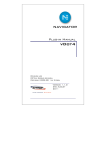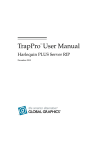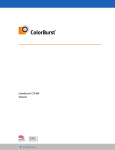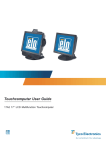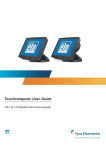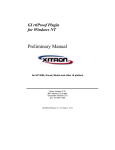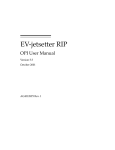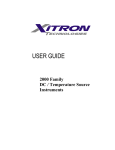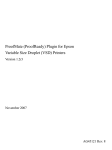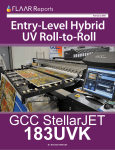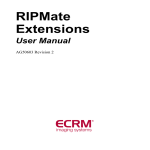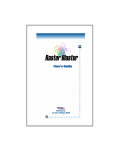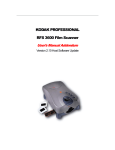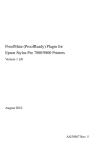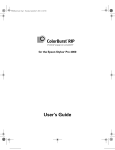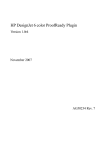Download ProofReady and vDot Plugins Install and Reference
Transcript
ProofReady® and vDot Plugins for Epson and HP Install and Reference Guide For use with Navigator RIPs on Windows NT 4.0 and 2000 / Macintosh OS 8.6 / 9 Including support for Epson 10000 under Windows 2000 only. p/n: 101-0009-007 Revision log RIP 5.5r1 Epson vDot 3.01e Epson ProofReady 3.2r4 HP ProofReady 1.0r2 HP 6 Color 1.0r1 Copyright © 2002 by Xitron, Inc. All rights reserved. No part of this publication may be reproduced, stored in a retrieval system, or transmitted, in any form or by any means, electronic, mechanical, photocopying, recording, or otherwise, without the prior written permission of Xitron, Inc. The information in this publication is provided for information only, is subject to change without notice, and should not be construed as a commitment by Xitron, Inc. Xitron assumes no responsibility or liability for any errors or inaccuracies that may appear in this publication. The software described in this book is furnished under license and may only be used or copied in accordance with the terms of that license. Windows and Windows NT are trademarks of Microsoft Corporation. Harlequin is a registered trademark of Harlequin Limited. Navigator is a registered trademark of Xitron Inc. Other brand or product names are trademarks of their respective owners and are used without intention of infringement. Contents Foreword ................................................................................................ ix Chapter 1: Supported Printers & Media ............................................... 1 1.1 Epson vDot plugin........................................................................... 1 1.1.1 Variable Dot 6 /7 color printers ............................................ 1 1.2 Epson ProofReady.......................................................................... 1 1.2.1 Sheet Fed Printers ............................................................... 1 1.2.2 Roll Fed Printers .................................................................. 1 1.3 HP ProofReady ............................................................................... 1 1.3.1 HP 1000 Series .................................................................... 1 1.3.2 HP 2000 Series .................................................................... 1 1.4 HP 6 Color....................................................................................... 1 1.4.1 HP 5000 Series .................................................................... 1 1.5 Media .............................................................................................. 1 Special note about Epson 7500 and 9500 models ....................... 2 Chapter 2: Installation ............................................................................ 3 2.1 Configuration Requirements ........................................................... 3 Navigator NT ................................................................................. 3 Navigator MAC .............................................................................. 3 Note: Products requiring the Epson vDot plugin such as the Epson 10000 are not supported on the Mac platform. ............................. 3 2.2 MAC Platform Installation ............................................................... 4 2.2.2 Check Your RIP Configuration............................................. 5 2.2.3 Install ProofReady................................................................ 5 2.3 Windows NT / 2000 Platform Installation........................................ 8 2.3.1 Check Your RIP Configuration............................................. 8 iii Contents 2.3.2 Install Windows Drivers ........................................................ 8 2.3.3 Epson vDot Plugin (Stylus Pro 10000) ................................. 8 2.3.4 Firewire ................................................................................. 8 2.3.5 Configuring and Testing the Windows Printer Driver ........... 8 2.3.6 High Speed Parallel Card ................................................... 10 2.3.7 Install ProofReady Plugin ................................................... 10 Chapter 3: Setup RIP for Proofing....................................................... 13 3.1 Introduction to Setup ..................................................................... 13 3.2 Memory Settings............................................................................ 13 3.2.1 Macintosh ........................................................................... 13 3.2.2 PC ....................................................................................... 13 3.2.3 All Platforms........................................................................ 14 3.3 Feature Passcodes........................................................................ 14 3.4 Device Manager Settings .............................................................. 15 3.4.1 Epson vDot Plugin .............................................................. 16 3.4.2 Epson ProofReady Plugin .................................................. 16 3.4.3 HP Design Jet 1000/2000/3000 Series (HP rtl Plugin)....... 16 3.4.4 HP Design Jet 5000 Series (HP 6 color plugin) ................. 17 Chapter 4: Epson vDot (Epson 10000) Creating a Page Setup – Configuration Choices.......................................................................... 19 4.1 What’s Involved ............................................................................. 19 4.2 Printer ............................................................................................ 20 4.3 Introduction to Resolution.............................................................. 20 4.4 Configure The Plugin..................................................................... 21 4.4.1 Output Media (and Plotting Resolution) ..................................... 22 4.4.2 Plotter ......................................................................................... 22 4.4.3 Color Controls............................................................................. 23 4.4.4 Clipping, Tiling and Repeating ................................................... 24 4.4.5 Progressive Proofing .................................................................. 25 4.5 Page Setup Controls ..................................................................... 25 4.5.1 RIP Resolution............................................................................ 25 4.5.2 Image Orientation and Scaling ................................................... 26 4.5.3 Calibration and Color Management............................................ 26 Separation Style .......................................................................... 27 Calibration (with color management)........................................... 27 Chapter 5: Epson and HP ProofReady Creating a Page Setup – Configuration Choices.......................................................................... 29 iv 5.1 What’s Involved............................................................................. 29 5.2 Printer............................................................................................ 30 5.3 Resolution ..................................................................................... 30 5.4 Connection Method....................................................................... 31 5.5 Paper Size & Source..................................................................... 33 5.6 Quality ........................................................................................... 34 5.7 Media Selection (Calibration and Color Management)................. 34 5.7.1 Separation Style................................................................. 35 5.7.2 Calibration (with color management) ................................. 35 Chapter 6: Testing your ProofReady Installation.............................. 37 6.1 Printing a Test File ........................................................................ 37 6.2 Info and ROAM functions.............................................................. 37 6.3 Printing .......................................................................................... 39 Chapter 7: Creating Appletalk Input ................................................... 40 7.1 Introduction ................................................................................... 40 7.2 Create Input Channel.................................................................... 40 7.3 Using the Input Channel ............................................................... 41 Chapter 8: Calibration .......................................................................... 42 8.1 Introduction ................................................................................... 42 8.2 Tools and Materials Needed ......................................................... 42 8.3 Printing A Target ........................................................................... 43 8.4 Measuring the Target.................................................................... 44 8.4.1 Using Genlin....................................................................... 44 8.5 Entering Measurement Data ......................................................... 45 8.5.1 “Profile”............................................................................... 47 8.5.2 Name.................................................................................. 47 8.5.3 Resolution .......................................................................... 47 8.5.4 Enter Data (Manual)........................................................... 47 8.5.5 Import Data From Strip Reader.......................................... 47 8.6 Using the new Calibration Set....................................................... 48 Chapter 9: HIPP Color Management System ..................................... 49 9.1 Introduction ................................................................................... 49 9.2 About HIPP ................................................................................... 49 9.2.1 Input and Output Profiles ................................................... 49 9.2.2 Color Gamut....................................................................... 50 v Contents 9.2.3 “In Job” Color Management................................................ 50 9.2.4 Custom Profiles and Media ................................................ 50 9.2.5 A Word About Spot Colors ................................................. 50 9.3 Creating an HIPP Color Setup ...................................................... 51 9.3.1 CMYK Input Profile ............................................................. 53 9.3.2 RGB Input Profile................................................................ 53 9.3.3 Output Profile...................................................................... 53 9.3.4 ICC Rendering Intents ........................................................ 54 9.3.5 Other Controls .................................................................... 55 9.4 Using An HIPP Color Setup .......................................................... 56 Appendix A: Troubleshooting.............................................................. 57 USB Connection not showing up in RIP (Macintosh with Epson Printer) ................................................................................................. 57 Printer Not Ready ................................................................................ 59 I am using a network connection, but I get a communication error when I try to print to my printer............................................................ 59 I have configured an NT Printer to spool the document to my printer using the ‘File’ output method but I am getting a communication error (or just no output) when I try to print.................. 60 Job is printing to server, but there is no output from the proofer......... 60 I can’t configure my RIP to print with Firewire. .................................... 60 I have properly set up my NT Printer and am getting output but I am getting random communication errors and gibberish. ................... 60 Output Too Slow with High Speed Parallel or Network interface ........ 61 Paper White Looks Yellow................................................................... 61 Streaks/Lines in Output ....................................................................... 61 When I Start To RIP A New Job, The Current Job Slows or Stops. ... 61 Can I Use TrapWorks with Epson printers? ........................................ 62 I get an error using the a Page Feature with Progressive Proofs (Epson vDot)........................................................................................ 62 When printing to an Epson 10000 the RIP sometimes won’t output (Epson vDot)........................................................................................ 62 Appendix B – Notes on Media, Resolution and Color Management for the Epson vDot Plugin (Epson 10000) ................................................ 63 Media Selection and the Epson 10000................................................ 63 Using Non-Standard Media ................................................................. 63 Resolution and Color Management..................................................... 64 vi vii Foreword Thank you for purchasing a quality Xitron product. The ProofReady and vDot plugins are provided to add high quality proofing capability to Xitron Navigator Imagesetter and CTP RIPs supporting both HP and Epson printer ranges. The supported devices and media are listed in Chapter 1. These same features can be obtained in the stand-alone XPR series of RIPs for which a separate installation and setup manual, the XPR Quick Start Guide, has been written. This manual is intended both as a Reference Manual for the XPR RIP, and as an installation and reference manual for the ProofReady and vDot Plugins on their own. You do not need any special programming or technical skills to install and use the ProofReady and vDot plugins; however it is a good idea to fully read through this documentation in order to understand the procedures involved with successful use of this product. This manual guides you through the installation procedure and explains how to print test output jobs from your RIP on a color printer. Full support for ICC Profile Color Management is included. ICC profiles have become the industry-preferred method of color control. All color generated by the ProofReady plugins is controlled by our included ICC profile processor (HIPP). Properly used, exceptional ink control including “contract color” can be attained. ix Foreword An extensive range of profiles is supplied with your ProofReady and vDot plugins, covering a wide range of standard media. These profiles will work well with your printer provided it is in good condition, has had all recommended nozzle cleaning and alignment procedures carried out, is using the correct media for the profile and uses recommended inks. You will improve accuracy even further by calibrating your particular printer using the procedure set out in Chapter 8. For ultimate accuracy, and especially if you wish to use other media than those for which profiles and calibration are already supplied, you will need to generate a custom ICC profile for your printer. This manual does not cover the topics of adding support for custom media and the creation and installation of custom ICC profiles. These areas require additional information, software tools and training. Contact your supplier for information about the availability of these items. x This manual has been designed to be cross-platform for both our Macintosh product and our Windows 4.0 NT product. In some places, where different procedures and screens exist, instructions will be provided for each platform individually. See example below: Typical Macintosh Installer Typical NT Installer However, in most cases, the only difference between the platforms will be the appearance of the windows. (See example below.) In these cases, only one version of the window will be shown (MAC or NT): Macintosh New Page Setup NT New Page Setup xi Chapter 1: Supported Printers & Media 1.1 Epson vDot plugin 1.1.1 Variable Dot 6 /7 color printers • Epson 10000 Pre-calibrated color is available for the Photo Dye Ink Set only. Users of the Pigment Ink model will need to make color adjustments or obtain their own ICC Profiles for this product. 1.2 Epson ProofReady 1.2.1 Sheet Fed Printers • Epson 3000, 5000 1.2.2 Roll Fed Printers • Epson 7000, 7500, 9000, 9500 1.3 HP ProofReady 1.3.1 HP 1000 Series • HP Design Jet 1050/ 1055 1.3.2 HP 2000 Series • HP DesignJet 2000/2500. 3000/3500 1.4 HP 6 Color 1.4.1 HP 5000 Series • Hp DesignJet 5000 1.5 Media There are many hundreds of media being marketed for use with Ink Jet printers, from the printer manufacturers such as Epson and HP, from 1 2 Chapter 1: Supported Printers and Media established Graphic Arts suppliers such as Mitsubishi or Agfa, and from many other third part vendors. Many of these media have very similar names, and in some cases media even from one supplier can have almost identical names. For example Epson’s Photo Quality Glossy Paper, Glossy Photo Paper and Photo Glossy Paper are all different products with different characteristics, while Epson’s SemiGloss Paper-Heavy Weight and Semigloss Photo Paper are in fact the same product, as sold in different regions. The Xitron XPR series of Proofer RIPs and the ProofReady and vDot plugins, include a library of color profiles and calibrations for specific media, and accurate results are only possible if the correct media is used. The Xitron document “Media for Ink Jet Printers” contains an up-to-date list of the specific media (and ink sets) supported by Xitron’s Proofing Products. Please check this document to make use you are using the correct RIP settings for your media. The latest version is always available at our web site, www.xitron.com. Special note about Epson 7500 and 9500 models The Epson 7500 and 9500 models use pigment based inks to achieve long life and fade resistance. These inks are well suited to advertising posters, archival photographic images, etc. However these characteristics require some compromises in the color gamut of the inks concerned. Xitron recommend the use of dye based ink models for the most accurate pre-press proofing applications. 2 Chapter 2: Installation 2.1 Configuration Requirements In order to use the ProofReady plugins you must have a Navigator RIP that meets the following requirements. It is assumed that the RIP is fully installed and operational. If you have problems with your RIP you should resolve those before installing the ProofReady plugin. This manual deals only with the additional information needed to be successful with the ProofReady plugin, and does not attempt to cover all of the RIP features and requirements. Navigator NT • Windows 2000 (SP2)† equipped PC. • Minimum 256 MB RAM. • 2 GB free disk space. • Second parallel interface or Ethernet Connection– (ProofReady is not able to share a parallel port with your Navigator dongle. Ethernet connection can use either Epson’s or HP’s optional Print Servers, or an external Print Server such as the Axis product recommended by Xitron). For the Epson 10000 a USB or Firewire port is recommended. • Xitron Navigator RIP revision 5.3r2 or later. † The Epson ProofReady Plugin for all models of Epson Stylus Pro except those using the vDot Plugin (currently the Epson 10000) can also be run on an NT4 SP 4 or 6 platform. Navigator MAC Note: Products requiring the Epson vDot plugin such as the Epson 10000 are not supported on the Mac platform. • Power Macintosh G3/G4 (or iMAC) with USB and OS 8.6 or 9.0. • Minimum 256 MB RAM. 4 Chapter 2: Installation • • 2 GB free disk space. Epson USB/Parallel (C-USB-PK4) cable (for Epson printers only) or Ethernet Connection. (Ethernet connection can use either Epson’s or HP’s optional Print Servers, or an external Print Server such as the Axis product recommended by Xitron). Xitron Navigator RIP revision 5.3r2 or later. 2.2 MAC Platform Installation 2.2.1 Epson USB Cable If you wish to connect your Epson printer with a USB cable, make sure that you have connected the printer to the RIP platform with an Epson USB/Parallel cable, Epson part # C-USB-PK4. Having the current Epson driver installed is essential so that the appropriate Epson USB drivers will be loaded into your system folder. These drivers will also provide you with a tool to check if the connection is good and perform printer maintenance. Install these drivers from the Epson CD that was shipped with your printer, or you can download the latest version from http://www.epson.com. After installing these drivers and connecting the printer, restart your Macintosh, and check that you can see the Epson printer in your Chooser on a USB port, as shown here for an Epson 5000: Fig. 2.1 Chooser showing Epson USP Driver Even if you are using an HP printer or not using the USB connection method with an Epson printer it is a good idea to install the native Macintosh printer driver supplied with your printer. This enables the printer to be tested, utility functions to be performed and draft proofs to be created direct from applications. Chapter 2: Installation 5 2.2.2 Check Your RIP Configuration Use the Apple > About Navigator menu selection to check the version of your Navigator RIP. The ProofReady plugins require version 5.3r2 or later. If your version is earlier than this please contact your supplier for an upgrade. The upgrade must be installed and configured with your imagesetter before continuing to install the ProofReady plugin. 2.2.3 Install ProofReady There are three ProofReady installers, located inside a folder “ProofReady Output Plugins” on the MAC Navigator CD (and the Xitron Plugins CD). The three installers are; For Epson Family:Epson PR Plugin x.yy For 4 color HP printers (Design Jet 1000, 2000/2500, 3000/3500):HP 1000/2000 PR Plugin x.yy For 6 color HP Printers (Design Jet 5000):HP 5000 PR Plugin x.yy Figure 2.2. Plugin Installation CD 6 Chapter 2: Installation Click on the ProofReady installer that matches your printer to install the plugin, and press Continue when you see the following window appear: Figure 2.3. Installation CD Title Screen At the next window select the RIP where you wish to install the ProofReady plugin. Locate the folder in which the RIP is installed, and check for the folder “SW” inside the RIP folder. Then click Install. Fig. 2.4. Installer Selection Window If the Installer gives an “Unable to find…” error at this stage then it is not able to locate important components of the RIP. Try again, making sure you correctly locate the RIP folder and SW folder. The installer will now copy the plugin and support files to the RIP. During this process you will see progress information like this: Chapter 2: Installation Figure 2.5. Installation progress 7 8 Chapter 2: Installation After the installation is complete, click on Quit to close the Installer. 2.3 Windows NT / 2000 Platform Installation 2.3.1 Check Your RIP Configuration Use the Navigator > About Navigator menu selection to check the version of your Navigator RIP. The ProofReady plugins require version 5.3r2 or later. If your version is earlier than this please contact your supplier for an upgrade. The upgrade must be installed and configured with your imagesetter before continuing to install the ProofReady plugin. 2.3.2 Install Windows Drivers To enable the use of the utilities provided by Epson and HP (such as print head alignment and nozzle cleaning), it is a good idea to install the latest version of the Windows driver for the printer you are using. You may perform this installation from the CD that came with the printer, or you may download the latest drivers from the Internet, at http://www.epson.com or http://www.hp.com 2.3.3 Epson vDot Plugin (Stylus Pro 10000) If you are installing the Epson vDot Plugin it is an essential part of the installation process that you install the Epson Windows Printer driver. It is recommended to do this before installing the plugin. This manual assumes that you have installed this driver, and that it’s name is “EPSON Stylus Pro 10000”. 2.3.4 Firewire If you plan on using Firewire (IEEE 1394) to connect to your Epson Stylus Pro 10000 then you must also install the firewire drivers in accordance with Epson’s instructions, make sure the printer is installed with the correct name, and test the Driver Installation before proceeding. 2.3.5 Configuring and Testing the Windows Printer Driver To configure and test a Windows printer driver, proceed as follows: Click on Start, go to Settings, Printers and click to open the window. Highlight the item EPSON Stylus Pro 10000, right click and click on Properties. Select the Advanced tab. Chapter 2: Installation 9 Fig. 2.6 Windows Printer Advanced Tab Make sure the “Spool print documents…” radio button is selected. For maximum throughput (proofs per hour) select “Start Printing after last page..”. For the shortest time to process individual proofs, select “Start Printing Immediately.” Select the Ports tab. Fig. 2.7 Windows Driver Ports tab Check that the port shown is your preferred connection method. The Stylus Pro 10000 driver provides great flexibility of interconnection method by using 10 Chapter 2: Installation any method supported by the Windows Printer driver. In this figure a Firewire port is shown, which provides the best performance of all available methods. Select the General port and click on Print Test Page to test the Windows driver, printer and connection method. Resolve any problems at this stage before installing the plugin or launching the RIP. If you experience any difficulties at this stage consult your Epson documentation and on-line help facilities. 2.3.6 High Speed Parallel Card If you are adding the High-Speed PCI parallel card for use with the plugin, do so before installing the RIP. Disconnect the power cable on the back of your PC and install the high-speed parallel card in any open 32 bit PCI slot in your PC. Connect the provided Xitron dongle in your installation kit to the LPT1 port (built-in parallel port, not the newly installed high-speed parallel port) on your PC and start up your PC. If you are installing on an NT 4 system install the driver that resides on the floppy disk that comes with the parallel card following the instructions included with the card. If you are installing on Win 2k you will find drivers and instructions on your XPR or Navigator CD in a folder “Intek Parallel Card Win2k”. If you experience any difficulties with the installation or operation of the card please check with Intek’s web site at www.intek21.com. 2.3.7 Install ProofReady Plugin Insert your Navigator RIP CD. After the start-up window appears click on the large button “Install Plugins”, then click on Next. (If you are installing from Xitron’s Plugins CD instead of the Navigator CD, then you will see a Welcome to the Install Shield for Plugins” window. Click on Next.) The Installer extracts files, and the following window appears: Chapter 2: Installation 11 Figure 2.8. PC Installation Screen Check that the destination folder is the correct location for the RIP you are installing the Plugin on. If it is not correct use the Browse button to locate the correct folder, then click on Next. At the next screen scroll through the list of possible plugins, and confirm the installation you wish to make. Confirm your selection by checking the boxes as shown below, then click on Next. Fig. 2.9. Installer Selection Window 12 Chapter 2: Installation If the Installer gives a “RIP Not Found…” error at this stage then it is not able to locate important components of the RIP. Click on Back, and re-confirm that you have correctly specified the RIP destination folder. The installer will now copy the plugin and support files to the RIP. During this process you will see progress information like this: Figure 2.10. Installation progress After the installation is complete, click on Finish to close the Installer. Chapter 3: Setup RIP for Proofing 3.1 Introduction to Setup Now that your ProofReady Plugin is installed, you need to configure certain options in the RIP. These options are divided into two groups – initial setup and configuration choices for media and quality. Chapters 3 and 4 explain how to do this. 3.2 Memory Settings 3.2.1 Macintosh a) Overall Memory Allocation Highlight the Navigator ppc icon, hold down the Apple key and press “I”. In the Information Window Show “memory”, enter 150000k for the preferred size and 100000k for the minimum size. Close the window. b) Memory Reserved for System Launch the RIP, select Navigator > Configure RIP > Options. Enter 15000 kb for memory Reserved for System. Click OK. Click OK. Exit and re-launch the RIP. 3.2.2 PC a) Overall Memory Allocation Launch the RIP, select Navigator > Configure RIP > Options and make sure the “Memory For RIP” box is not checked. b) Memory Reserved for System No special setting required. 14 Chapter 3: Setup RIP for Proofing 3.2.3 All Platforms Launch the RIP and make the following adjustments: a) Band Size Select Navigator > Configure RIP > Options and set Band Size for Printing Buffer to 1000 kb. Click OK. b) Printer Buffer In the Configure RIP window enter 40000 kb for Printer Buffer. Click OK. Exit and re-launch the RIP. 3.3 Feature Passcodes With your ProofReady plugin kit you will have received a printed sheet with passcodes listed. These are required to enable a number of specific features in your Navigator RIP for use with the ProofReady plugin. To enter these codes, select Navigator > Configure RIP > Extras Fig. 3.1 Configure RIP Extras Dialogue For each item, highlight it in the list, and click Add. Enter the passcode, and click OK. The items to be added are: a) HDS (or HDS Lite) (Not required for vDot plugin) Chapter 3: Setup RIP for Proofing 15 This is a screening option that enables Stochastic and Error Diffusion screening for the ProofReady plugin. b) HIPP (or HCPS) These Color Management options enable the processing of ICC profiles for accurate color matching. c) Epson or HP Model xxx For each printer model that you wish to drive you need to enter the appropriate passcode. When you have entered all the codes supplied, click on OK twice, exit and re-launch the RIP, return to the Configure Rip >Extras dialogue and make sure all the entries you added show up as “Yes” in the list. If any do not show “yes”, check and re-enter the passcode. 3.4 Device Manager Settings The Device Manager allows you to select and name the output devices you will be using in the RIP. Select Navigator > Device manager. At the top of the window is a list box entitled Plugin. Check that the box shows the entry “epsonplg”. If not select epsonplg from the list of available plugins. Fig 3.2 Device Manager Dialogue Some entries may already be filled in. If so you can leave these, or re-name them something more useful. At a minimum you need to have at least one Name entry for each different printer. In the above example we are adding a name “Nicki’s 5000” to the list, and associating that name with the device type “Stylus5000-EDS”. Each printer model has several Device Types, the differences being as follows: 16 Chapter 3: Setup RIP for Proofing 3.4.1 Epson vDot Plugin Stylus 10000 vDot This is a universal device using variable dot error diffusion screening, and suitable for Sheet or Roll fed media. 3.4.2 Epson ProofReady Plugin a) Stylus9000 (or 3000 or 5000 or 7000 or 7500 or 9000 or 9500) This device type uses either conventional half-tone or stochastic (HDS) screening and is configured to use sheet fed media. b) Stylus9000_Roll This device type also uses conventional or stochastic screens, but with roll fed media. c) Stylus9000_EDS This device type uses Error Diffusion screening, the highest quality, with sheet fed media. d) Stylus9000_Roll_EDS Finally this device type uses both Error Diffusion screening and roll media. Since the highest quality output is obtained using Error Diffusion screening the remainder of the examples in this manual will assume the use of EDS device types where available. If you wish to use, for example, both sheet and roll media with an Epson 9000 printer, you will need to enter Names for each of these two device types. The Names you choose will be used later to identify which printer you are working with, and can be any useful name, though in this example it would be a good idea to have the words Sheet and Roll in the names. 3.4.3 HP Design Jet 1000/2000/3000 Series (HP rtl Plugin) All HP 1000/2000/3000 series drivers use conventional dot or stochastic (HDS) screening. a) Mono Roll Black ink only for roll fed media. b) Mono Sheet Chapter 3: Setup RIP for Proofing 17 As above for sheet fed media. c) Roll Full color for roll fed media. d) Sheet As above for sheet fed media. 3.4.4 HP Design Jet 5000 Series (HP 6 color plugin) For each of the two product widths there are four driver options: a) Contone Roll This driver configures the RIP to create a 4 color (CMYK) continuous tone rendering of the page that is sent to the HP Printer. The processes of error diffusion screening and creation of the additional color channels Light Cyan and Light Magenta, are carried out in the printer itself. The driver is for roll fed media. b) Contone Sheet As above for sheet fed media. c) 6-Color Roll This driver performs screening and 6 color (CMYKc’m’) separation in the RIP using conventional dot or stochastic (HDS) screening d) 6-Color Sheet As above for sheet fed media. The removal of the requirement to do screening in the RIP reduces RIP time when the Contone drivers are used. However the substantially increased amount of data to be sent to the printer (32 bits per pixel instead of 6) may eliminate this benefit. In practice the choice will usually depend on the user’s preference for one form of screening over another. The choice of device type completes the initial Setup of the RIP to use the ProofReady plugin. The next step is to configure specific details needed to produce output. Chapter 4: Epson vDot (Epson 10000) Creating a Page Setup – Configuration Choices Note: This chapter covers the Epson 10000. For the Epson 3000, 5000, 7000, 7500, 9000, 9500 and HP Design Jet 1000, 2000 and 3000 series see Chapter 5 4.1 What’s Involved In this section you will create one or more Page Setups for your printer. The Page Setup includes settings for printer, resolution, connection method, print quality and media selection (which sets calibration and color management). These items are reviewed in turn. To start, select Navigator > Page Setup Manager, and click New. The Page Setup dialogue looks like this: 20 Chapter 4: Creating Page Setup Epson vDot - Configuration Choices Fig 4.1 Page Setup Dialogue 4.2 Printer To select the printer model and mode for this Page Setup, select it in the Devices list box. In this example we are selecting the printer type “Stylus 10000 vDot”. 4.3 Introduction to Resolution In a RIP product such as the Xitron Navigator driving a plotting device such as the Epson Stylus Pro 10000, the term Resolution has two distinct uses. This stems from the fact that the RIP first processes the incoming data into a continuous tone raster at a specified resolution, called the RIP Resolution, and then in a second process at output time these continuous tone data are Chapter 4: Creating Page Setup Epson vDot - Configuration Choices 21 screened and output on the printer at what may be a different resolution, called the Plotter Resolution. For further details about the significance of these parameters see Appendix B, Resolution and Color Profile Issues 4.4 Configure The Plugin From within the page Setup dialogue, locate the button near the top left corner of the screen marked “Configure Device”. Click this button to open the Epson 10000 Device Configuration window. Note: that many of the variables in this window can be changed after the job is RIPped. To do so, highlight the job in the Active or Held queues in the Output Controller, click Info then Configure Device. You will see the same display as below, but some functions will no longer be available (such as Progressive Proofs) because they are processed at the time the job is RIPped. However many other functions, such as Repeat to fill media or Horizontal Tiling, can be selected as this stage, either before the job is printed, or before re-printing it, which is done by dragging it back to the Active Queue. Figure 4.2. Epson 10000 Configuration dialog box 22 Chapter 4: Creating Page Setup Epson vDot - Configuration Choices 4.4.1 Output Media (and Plotting Resolution) The large window at the top of the screen lists the various media types supported by the Epson vDot Plugin for this printer. Also listed are the various RIP and Plotter Resolution options (see Appendix B for more information), a Media ID value, and typical part numbers for each media type, where known. It is very important that the media is exactly correctly specified as there are numerous settings including color management, ink drop size and speed, ink nozzle control etc. that vary from one type to another. On the left of the window are icons against each entry, which present useful information as follows: The current RIP Resolution is incorrect for this choice. The current RIP Resolution is correct for this choice. The current RIP resolution is correct and there is an available calibration for this choice. In most cases if the RIP resolution is incorrect there will be another choice for the same media with the current RIP resolution. If not you can still choose the media, but you should then change the RIP resolution to the correct value when you exit the Configuration dialogue (see 3.4 below). If you need to use a media type not listed, see Appendix B. 4.4.2 Plotter The section labeled “Plotter” contains entries related to the connection of the printer. The list box next to the icon of a printer should show the previously installed Epson Stylus Pro 10000 Windows Printer Driver. If not select it now. It is possible to output through another Windows driver, but this is not recommended. If you wish to output to a file for printing later, choose File from this list and enter the path and filename below. You can also choose to output directly to a parallel port to your printer, but this will cause the RIP to remain busy throughout the output process, considerably reducing productivity. Chapter 4: Creating Page Setup Epson vDot - Configuration Choices 23 Check the box Automatic Cutter if you are using roll media and wish each job processed to be cut from the roll when printed. The box Special Codes is reserve for use by Xitron technical support staff. Do not put any information in this box unless asked to do so by our support staff or their representative. The box Pigmented Inks should be checked if your Epson Stylus Pro 1000 is fitted with Pigment Inks. The remaining controls in this section are inactive unless you select “User Defined” as your Output Media. See the Reference Manual for more information. The box Give More Time For Windows should normally be checked. If your RIP output speed seems slow, and you have at least 512 M Bytes RAM in your PC, you can uncheck the box and compare results. 4.4.3 Color Controls The Xitron Epson vDot Plugin provides two methods of color control. These are: a) through the use of ICC Profiles, b) manually. The four sliders in the Configuration dialogue provide the manual method of color control, but they can also be used to make adjustments when ICC Profile based color management is in use. The icons at the top of each slider control can be used as a quick way to reset each control to zero. Moving the sliders up or down from zero increases or decreases the particular color channel – the units shown are %, so if you set Cyan to +10 all values of Cyan in the image will be increased 10%. The Brightness control changes all ink channels together to make the overall image lighter or darker. The Composite Black check box controls the imaging of 100% Black objects. These are normally printed in black ink which creates sharper text. If the box is checked these objects are imaged in Cyan, Magenta and Yellow inks, which may produce smoother shadows in photographic images. 24 Chapter 4: Creating Page Setup Epson vDot - Configuration Choices 4.4.4 Clipping, Tiling and Repeating The Xitron Epson vDot Plugin has additional special features for tiling or clipping large images and repeating small ones. These features are described here. First specify the Media Type and Size in the Media list box and the Width and Height entries. If you wish to use cut sheets select Sheets from the Media list. Each sheet has to be individually hand loaded into the printer before output. Refer to your Epson 1000 manual for details of permissible sheet sizes and thicknesses. Print Horizontal Tile controls the tiling system. When set to Never only one print is made from each job. If the job is too wide for the media it will be clipped to the value shown in Media Width. If you simply want to print only part of the job enter the width you wish to clip to in the Media width box. If Print Horizontal Tile is set to All then as many tiles are created as needed to output the job. Each tile will be the full height of the job (assuming roll media), and the width will be equal to the value entered in the Media Width box. To print one tile at a time, Print Horizontal Tile can be set to the tile number required. Tiles are numbered from left to right, and tiles overlap by about 0.5 inches. The Repeat job to fill media width check box controls step-and-repeat printing. This box is only available if Print Tile Number is set to Never. If the box is checked then jobs are repeated as many times as they will fit across the available media width, as set in the Media width box. For example if the Media width box is set to 35.6 inches (when using 36 inch roll media) and an 8.5 inch wide job is processed, then the job will be repeated 4 times across the width of the roll. If more copies are required the Number of rows can be set to any value up to 10, which would yield a total of 40 copies in this example. The Indent image box moves all images across the media from the origin point in cases where blank space is needed to the left of the image. The Units list box allows the measurement units for all of these controls to be set to Inches, MM or Points as required (based on the Units setting of your Windows 2000 installation). Chapter 4: Creating Page Setup Epson vDot - Configuration Choices 25 4.4.5 Progressive Proofing This special feature is primarily for printers running 4 color jobs on 2 color presses. An accurate proof can be created that shows the job after the first pass through the press, helping to ensure that when the final two colors are added the result is correct. The system is very simple and flexible, and enables any combination of 1, 2 or 3 colors to be printed as required. The Progressive Proofing feature can also be used to print one color at a time onto transparent media to create Color Keys. Overlaying the color keys gives the most accurate proof obtainable of registration problems, traps etc. To use the feature simply un-check the boxes for the colors that you do not wish to print, and check again to turn that color back on. When the color is off its icon is shown with a cross. Note that the Progressive Proofs option is incompatible with several standard Page Features such as Crop Marks and Imposition Features. If you are using Progressive Proofs we recommend not using Page Features in addition. Click on OK to return to the Page Setup Dialogue. 4.5 Page Setup Controls In the main page setup windows you can choose your RIP Resolution (but not Plotter Resolution, which is set when you select your media in Configuration, section 4.4.1 above), image orientation, scaling, calibration and color management. For further details about the settings in Page Setup see the Xitron Navigator Users Guide. 4.5.1 RIP Resolution Select the Rip Resolution in the top right corner of the Page Setup Dialogue. 26 Chapter 4: Creating Page Setup Epson vDot - Configuration Choices Fig 4.3 Rip Resolution Settings In this case we have selected the normal resolution for high quality proofs, 720 by 720 dpi. 4.5.2 Image Orientation and Scaling The controls for orientation and scaling are in the lower right corner of the Page Setup Dialogue. Fig 4.4 Image Orientation and Scaling Use the controls to change the orientation of the printed image, and to scale it (up or down) in the X and Y axes. The “Trim Page” option removes any large amounts of white space from the top and bottom of the image. 4.5.3 Calibration and Color Management Controls for Calibration and Color Management are located on the left hand side of the Page Setup Dialogue. Chapter 4: Creating Page Setup Epson vDot - Configuration Choices 27 Fig. 4.5 Calibration and Color Management Controls Separation Style First set the Style list box to CMYK Composite. This is the only option available. Calibration (with color management) The vDot Plugin is supplied pre-configured with calibration and color management for specific media types, and the calibration curve which corresponds to the Output media specified in step 4.4.1 should be selected here. This Calibration is pre-configured to apply ICC Profile based color management targeted at a standard SWOP press. To accept this option choose “None” in the Color list box. If you wish to configure ICC based color management differently then you can create a special Color Setup, details of which are contained in Chapter 9. If you wish to calibrate your individual printer to match the pre-configured calibration state, see Chapter 8. You will only get accurate color with exactly the correct media and the correct resolution, though you may find acceptable results for some applications by using substitutes if you have to. If the RIP is able to detect that you have made an incorrect combination of settings you will be warned when a job is processed. For example if you select a calibration profile in Page Setup for a different media than that chosen in the Configuration dialogue you will see the following warning: 28 Chapter 4: Creating Page Setup Epson vDot - Configuration Choices Fig 4.6 Mis-matched Profile Warning Then click on Save As (or Save if you are editing an existing Page Setup) and give your new Page Setup a useful name. Chapter 5: Epson and HP ProofReady Creating a Page Setup – Configuration Choices Note: This chapter covers the Epson 3000, 5000, 7000, 7500, 9000, 9500 and HP Design Jet 1000, 2000 and 3000 series. For the Epson 10000 see Chapter 4 5.1 What’s Involved In this section you will create one or more Page Setups for your printer. The Page Setup includes settings for printer, resolution, connection method, print quality and media selection (which sets calibration and color management). These items are reviewed in turn. To start, select Navigator > Page Setup Manager, and click New. The Page Setup dialogue looks like this: 30 Chapter 5: Creating Page Setup HP and Epson ProofReady - Configuration Choices Fig 5.1 Page Setup Dialogue 5.2 Printer To select the printer model and mode for this Page Setup, select it in the Devices list box. In this example we are selecting the printer type “Nicki’s 5000” we created earlier. 5.3 Resolution Resolution can now be selected from the list boxes in the top right of the window. The choices available will depend on the printer type selected. Fig. 5.2 Select Resolution Chapter 5: Creating Page Setup HP and Epson ProofReady - Configuration Choices 31 In this example we have selected 720 dpi which is a suitable value for high quality images without extended processing time. 5.4 Connection Method With the Page Setup window still displayed, click the “Configuration” button, and the following window will appear: Fig. 5.3 Configuration Dialogue – Macintosh Select the correct Connection Method, as follows: • Windows NT • Printer Port 1 or 2 (or LPT1:, LPT2:) are the conventional Parallel Ports. If you have installed the PCI High Speed parallel interface shipped with Navigator XPR this will appear as Printer 2. Make sure you use a high quality parallel cable. • Network is a TCP/IP connection across your Local Area Network. If you use this method you must put the correct IP address and Port Number in the boxes at the bottom of the window. The IP address must match the address of the printer, and be within the range of the Subnet Mask on your computer. The Port Number is 9100 for “Jet Direct” print servers, and 515 for Epson’s internal Ethernet servers. If you use an external third party Print Server check the documentation supplied with that product to identify the correct port number to use. • File creates output on a disk file for output through some other 32 Chapter 5: Creating Page Setup HP and Epson ProofReady - Configuration Choices system. This file can be directed to any installed NT Printer to take advantage of the NT Print Spooler, in which case whatever connection method the NT Print Driver has been setup for will be supported by the RIP. To do this the field next to ‘Browse Files’ should be formatted as: \\COMPUTERNAME\ while the File Template should have the printer share name, such as \HPDesignJet5000\ Fig. 5.4 Connecting a Windows Printer Driver Make sure that the name of your computer is in ALL CAPS. Make sure that you match the upper and lower case of the Printer share name exactly as it appears in NT. To find the Share name go to the Printers window, highlight the required printer, right-click and select Sharing. (Sharing also has to be turned on.) In this example the computer is called P166 and the printer share name is HPDesignJet5000. • Additionally, the File Output method can be used to specify an NT URL to send output directly to a printer or print server running the NetBEUI protocol. In this example an Epson 5000 is connected using an Epson Ethernet Server. The Server has been configured with NetBEUI protocols. The (default) Server Name is EP5000_A and the Printer Name is EP_5k. Chapter 5: Creating Page Setup HP and Epson ProofReady - Configuration Choices 33 Fig. 5.5 Connecting a NetBEUI Print Server • MAC • Network has the same function as with the PC. • Port: Modem and Port: Printer are standard MAC High Speed Serial ports. • In addition if the printer appears by name, e.g. Stylus Pro 5000, this connection method uses the Epson USB to Parallel adapter cable. If you wish to use this Connection Method and the printer does not appear, check the following points: • Make sure you have installed the Printer Driver software that was shipped with the printer or with the USB cable. • Check that the printer is connected, turned on and in a Ready state, then exit the RIP and re-boot your MAC. The printer has to be turned on after connecting the USB-Parallel cable. • The printer will only appear if it can be located in the Chooser of your Macintosh (see section 2.2.1, above). 5.5 Paper Size & Source The options appearing in the paper size list are paper sizes supported by the Plugin and the printer. Select your default paper size and click on OK. (Printing on paper sizes different from that selected in this window may cause clipping or image alignment problems.) Some printers have multiple paper sources; select the source you wish to use from the Paper Bin Selection list box. For roll fed devices you can click on the Cut After Page check box to instruct the printer to cut the roll after each image. 34 Chapter 5: Creating Page Setup HP and Epson ProofReady - Configuration Choices 5.6 Quality The Quality list box allows various choices depending on the printer model and screening technology being used. For Epson printers there is a choice of Enhanced, Standard or Fast Microweave. This setting refers to the way the print heads are driven. In Enhanced mode printing is in one direction only, and the print heads print a limited area on each pass. Fast Microweave prints in both directions with maximum head coverage. Standard is a compromise setting. We recommend using Fast Microweave only in conjunction with 360 dpi resolution for fast draft proofs, and Enhanced Microweave with higher resolutions for the best quality. You can experiment with the effect of changing resolution and quality mode to find settings best suited to your workflow requirements. (Additionally in exceptional cases performance may be improved by selecting a Compression Mode of None in place of the default Run Length. This is only likely to occur with very complex images – if you have such an image and you consider the printing speed – not the RIP processing time – to be slow try setting Compression Mode to None.) For HP printers some models have a choice of Printer Default, and Fast / Normal / Best modes. Use the Printer Default as a starting point, and experiment with the other settings (as well as resolution) if you need to optimize speed or quality. Once you have confirmed that the Connection Method and Paper and Quality settings are correct click OK twice to return to the Page Setup Manager. 5.7 Media Selection (Calibration and Color Management) In the Page Setup dialogue media and color selection are made with the controls on the left-hand side of the screen. All ProofReady plugins incorporate an automatic pre-calibrated form of color management that provides accurate results for the default conditions, provided that you use one of the supported media types, and the correct inks, and that your printer is in good condition. It is important to carry out head cleaning and other procedures from time to time to maintain accurate color. This section covers only these default settings. For information on creating your own color management setups, see Chapter 8. Chapter 5: Creating Page Setup HP and Epson ProofReady - Configuration Choices 35 Fig. 5.6, Color and Media Controls 5.7.1 Separation Style First set the Style list box to PhotoInk Composite (or in the case of the 4 color Epson 3000 and HP Design Jet 1050, 2000, 3000 products, or the DesignJet 5000 Contone driver, CMYK Composite). These are the only options available. 5.7.2 Calibration (with color management) Select one of the available pre-set calibration curves that are supplied with the Plugin. See the chart in Chapter 1 for the exact name and part number for the media that goes with each calibration curve. You will only get accurate color with exactly the correct media and the correct resolution, though you may find acceptable results for some applications by using substitutes if you have to. When you have chosen the correct calibration curve you can also make any choices you need for rotation, scaling etc. of the printed image. Then click on Save As and give your new Page Setup a useful name. 36 Chapter 5: Creating Page Setup HP and Epson ProofReady - Configuration Choices Chapter 6: Testing your ProofReady Installation 6.1 Printing a Test File Once you have created a Page Setup it is time to output a sample print on your printer. To do so, begin by clicking on the checkbox marked ”Disable Output” on the Output Controller window. Then pull down the Navigator Menu and select Print File. From the list box choose the Page Setup that you have created for the ProofReady plugin (and on the PC select “pdf” in the “Files of Type..” list box.) Browse the system for the ProofReady install CD or folder. On the root of the CD is a file “Drupa Sample.PDF”. Select this file and click on Print. 6.2 Info and ROAM functions After the file has been processed by the RIP, which will take from about 1-3 minutes depending on the performance of your platform, it will appear in the Output Controller as shown here below. 38 Chapter 6: Testing your ProofReady Installation Fig. 6.1 The Output Controller With the job highlighted you can click the “Info” button and check the size, orientation, printer type etc. for which the job has been processed. Take particular note of the width and height of the job, and make sure it is within the limits of your printer. By clicking the “Roam” button you can obtain an onscreen preview of the job before outputting it. (To obtain a reduced scale ROAM view, on the PC use the menu on the ROAM window itself and select Reduced ROAM. On the MAC choose the ROAM > Reduced Roam menu item from the main XPR menu bar.) The test image distributed with the ProofReady plugin should appear as shown below. Fig. 6.2 Test Image Chapter 6: Testing your ProofReady Installation 39 6.3 Printing Once you are satisfied with the job to be printed click on the “Disable Output” box to release the job for output. As the job progresses you will see a gray bar appear in the central windows on the Output Controller. This progress bar indicates the proportion of the job that has correctly output. If the printer does not start to output after a few seconds check the output controller for error messages, and see Appendix A, Troubleshooting for further ideas. Chapter 7: Creating Appletalk Input 7.1 Introduction In order to print from a Macintosh workstation to the RIP using the ProofReady plugin, it is necessary to create one or more Appletalk input connections. This chapter describes the process of creating the input channel, and associating it with the Page Setup you created in Chapter 4 or 5. 7.2 Create Input Channel From the Navigator menu select Input Manager. When the Input Controller is displayed click New. Fig. 7.1 Add Input Channel Enter the name that you want to see in the workstation’s chooser in the Name field, and select Appletalk as the Type. From the Page Setups list box select the Page Setup you wish to use for this channel. Click OK. (You can create as many additional channels as you wish for different page setups.) Chapter 7: Creating Appletalk Input 41 7.3 Using the Input Channel From the Navigator menu select “Start Inputs” if it is not already selected. The RIP will display a message as it starts each input channel. From another Macintosh on the network you can now select your input channel in the usual way through the Chooser using a Laserwriter (or other PostScript) driver: Fig. 7.2 Appletalk Printer in Chooser Chapter 8: Calibration 8.1 Introduction The ProofReady plugin is supplied with a number of calibration curves for specific media and resolution. These curves have been created with reference printers of the same type that the plugin is intended to support. In many cases printers in the field will have characteristics so similar to the reference printers that no additional steps are needed to get good quality output. However if you want to get the very best out of the ProofReady system it can be helpful to calibrate your printer to compensate for differences between it and the reference machine. This chapter describes how to do this. 8.2 Tools and Materials Needed The RIP includes facilities for interfacing an automatic strip reading measurement instrument, such as the X-Rite DTP-41. This is the most convenient as it saves a great deal of time. However for occasional calibration you can also use any good quality instrument capable of reading color densities in Status T format. (Note that the DTP-41 is not only able to measure color densities, required for calibration, but is also a spectrophotometer which is a requirement if you plan to work with the creation of ICC profiles.) In addition you will require a good supply of the exact correct media (the RIP can only be calibrated against one of the media listed in Chapter 1 for which internal calibration targets are provided). Chapter 8: Calibration 43 8.3 Printing A Target Make sure you have created a Page Setup with the correct settings for the calibration targets. In Page Setup > Configuration you should choose Enhanced Microweave as the Quality selection. In Page Setup itself select a Calibration Curve for the chosen media, and make sure the resolution is also correct for that curve. There should be no entry in the Color list box. In this example we will calibrate an Epson 5000 using Epson Photo paper at 720 dpi. We have created a suitable Page Setup, and named it Epson 5k Photo. Go to the Output menu and choose Print Calibration. The following window will appear: Fig. 8.1 Print Calibration Highlight the correct Page Setup, and click on “Print Uncalibrated Target”. The RIP will generate a special four color target which you should print on the correct media type. The target image is show here: Fig 8.2 Calibration Target 44 Chapter 8: Calibration 8.4 Measuring the Target 8.4.1 Using Genlin If you do not have a strip-reading densitometer such as the DTP-41 supported by Genlin, and you wish to use a manual Status T densitometer, skip this section and go to 7.5, Entering Measurement Data. If you have the DTP-41 or similar instrument you need to operate it using an application called Genlin which is installed with your Navigator RIP. Locate the Genlin icon inside the RIP folder, launch it, and then select Configure from the menu bar. Fig. 8.3 Genlin Configuration Use the Browse button to locate the RIP that you are calibrating. Highlight the SW folder within the Rip folder before clicking the “Select SW” button. In the Instrument list box select the correct model for your measuring instrument. Set Measure to Status T, Media to Press paper, and set the Port to either Printer or Modem depending on where your instrument is connected. Click on OK. From the Menu bar choose Read Target. You will see a box with one or more Reference Numbers. Each time the RIP generates a calibration target it records the details in a data base, and gives each target a Reference Number. This number is printed on the target. Check the target printed in 7.3 above, note the Reference Number, and highlight the correct number in the list. Then click on OK. Verify in the next screen that Genlin is expecting to read the correct number of colors for this target, and click Read. Chapter 8: Calibration 45 For each color strip, Genlin shows a window similar to that shown here: Fig. 8.4 Genlin Prompt Arrange the target in the direction of the arrow with the first (Cyan) strip under the measuring head, and slide the target under the head until it stops. Then click OK, and feed the target gently through the reader. Repeat this process for each of the four colors, after which Genlin will display a message box: Fig 8.5 Genlin Finished Prompt Genlin has placed a file of measurement data in the RIP folder ready for the RIP to import. 8.5 Entering Measurement Data From the Navigator Menu Bar select Output > Calibration Manager. 46 Chapter 8: Calibration Fig. 8.6 Calibration Manager In the Device list box select the device that you are calibrating. This must be the same device name as was selected in Page Setup when you printed the Calibration Target. Click on New. Fig. 8.7 Calibration Editor Chapter 8: Calibration 47 8.5.1 “Profile” Select in this list box the same Calibration Profile that you chose in Page Setup, which must match the media. This underlying Calibration profile provides the target information (aim curve) that you are going to calibrate the printer against. 8.5.2 Name Enter a convenient name for this calibration set. 8.5.3 Resolution Calibration is only accurate at one resolution, so select the resolution that you set in Page Setup here. This prevents the accidental use of this calibration set at the wrong resolution. 8.5.4 Enter Data (Manual) If you are using a hand-held densitometer make sure it is set to the Status T response curve. Measure the density values for each Cyan patch on the target and enter these values in the boxes. When you have finished the Cyan data, select another color in the Channel list box, and repeat until all four sets of values have been entered. Then click OK. 8.5.5 Import Data From Strip Reader If you used Genlin to create an import data file, described in section 7.4 above, simply click on the Import button. Fig. 8.8 Import Dialogue 48 Chapter 8: Calibration The Import Measurements dialogue box shows a list of the four color channels that are contained in the import data file. Click on Import. The RIP will immediately import all the data values and change the numbers in all the boxes for all four colors. Click OK to save the Calibration Set. 8.6 Using the new Calibration Set Close the Calibration Manager and return to the Page Setup edit window. If you open the Calibration list box you will now see your new calibration set is available for use. Since the new calibration set is based on the originally supplied calibration profile the color management settings and performance are not changed. Selecting your new calibration set in Page Setup without any selected Color setup (see Chapter 8) will result in default color management as described in that chapter. If you select a specific color setup then that setup will become the active color management setting, just as it does for the original calibrations built into the RIP. Chapter 9: HIPP Color Management System 9.1 Introduction The ProofReady plugin system includes a special form of pre-installed color management that is sufficient for most users. When you select a “calibration” profile in Page Setup you are in fact choosing both calibration and color management for the specified media, resolution and printer type. This chapter explains how the pre-installed system is set up, and how to make certain changes to the color processing. The color management system in the Navigator RIP is based upon Harlequin’s HIPP (Harlequin ICC Profile Processor), an ICC based system that uses both Input and Output color profiles to achieve accurate and consistent results. 9.2 About HIPP 9.2.1 Input and Output Profiles When a PostScript file includes a color image the image is defined in either an RGB or a CMYK color space. Such images describe colors in what is called a ”device dependent” way. This means that the color in any particular location on the image can only be understood when the image is sent to an output device. A color defined as 50% red 50% green will appear as different shades of yellow depending on what it is viewed or printed on, and to an extent also on local lighting conditions and other variables. Similarly a color described as 100% cyan will appear to an observer of the printed results differently dependent on the characteristics of the ink, the paper, the press and other variables. 50 Chapter 9: HIPP Color Management System In order to achieve accurate color on a proofing product therefore the first step is to identify the “device” – that combination of inks, processes, paper, lighting, etc that the file will be sent to for final output. Once we know what the colors would look like, for example, on a printed piece, we can calculate how to represent those colors on a proof. These jobs are performed by the Input and Output profiles in HIPP. The Input Profile converts the device dependent colors in the job to absolute color values that would appear on a target device. The Output profile converts these absolute colors to device dependent CMYK values to send to a printer to create a proof. 9.2.2 Color Gamut The term gamut simply means the total range of colors that a particular device can reproduce. For proofing, gamut becomes a problem if the proofing device cannot reproduce all the colors that the original output device (printing press etc.) can. With typical presses and typical modern printers this is not an issue, except for Spot Colors that are often outside the typical CMYK gamut. 9.2.3 “In Job” Color Management Some PS and PDF files can contain color rendering dictionaries or other instructions to direct the way the RIP processes color. HIPP provides a switch to either ignore these instructions, using the pre-set HIPP settings instead, or to action them, in which case they are used in place of the HIPP settings. An exception to this is a PDF file with an included Input profile. If you have an HIPP setup and do not set the Ignore In Job Color Management switch, then the RIP will use the in-job profile as an Input profile, but still use the selected Output profile. 9.2.4 Custom Profiles and Media This manual covers only the use of the ProofReady plugin with the calibration profiles and ICC profiles supplied with the product. It is possible to add additional media types and custom profiles, but to do so requires tools and training not covered by this manual. Contact your dealer for information about custom media and profiles. 9.2.5 A Word About Spot Colors There is a special class of color space that is neither RGB nor CMYK. These are “spot” colors including Pantone® colors. The RIP has an extensive database of absolute color values for the popular families of spot colors, Chapter 9: HIPP Color Management System 51 including the full Pantone® range. HIPP accesses this database, by-passing the Input Profiles in the case of spot colors. The correct absolute color value is then passed through the Output Profile to obtain the closest rendition possible. Of course many spot colors have been created for the very reason that they cannot be readily reproduced on a CMYK press, so some spot colors may be outside the gamut of the printing device. These colors are handled using the Rendering Intent rules (see 8.3.4 below). 9.3 Creating an HIPP Color Setup The built-in color management is configured with the following options (which will be explained later in this chapter): RGB Input Plugin – Trinitron CMYK Input Plugin – SWOP Rendering Intent – Photometric Preserve 100% Black – Yes Set Background Color of input job – No Ignore In Job Color Management - Yes You may wish to create an HIPP configuration different from the built-in configuration, for example if our target device is not a SWOP press. To do so from the Color menu select Color Setup Manager. Fig 9.1 Color Setup Manager In the Device list box, select the device you created in the Device manager. Click New. 52 Chapter 9: HIPP Color Management System Fig 9.2 Color Setup Style Although three options are shown in the dialogue, only the first, HIPP, is valid for use with the ProofReady plugin, and you should click on HIPP. This opens the HIPP Setup Editor: Fig 9.3 HIPP Editor Chapter 9: HIPP Color Management System 53 9.3.1 CMYK Input Profile This is the profile used to convert incoming CMYK data into absolute color. Generally you should choose the closest available profile to the output system that the same job will be sent to for final output. For example, if you are going to print your jobs on a sheet fed offset press, then the closest choice is Commercial A. The default choice used by the built-in color management system is SWOP (CGATS TR001). 9.3.2 RGB Input Profile This profile is used to convert incoming RGB data. There are two available profiles, sRGB and Trinitron. sRGB is intended for use when the image has been scanned by an RGB scanner, and Trinitron is intended for use when the image will be displayed on monitor. For printed work it is recommended to convert the images into CMYK data before sending to the RIP. 9.3.3 Output Profile You must choose an output profile that has been created for the media that you are using for accurate results. As the figure below shows the ProofReady plugin is supplied with a library of standard profiles for popular media. The full list is shown at the front of this manual. This manual does not cover the creation or installation of profiles – for information about the tools and training needed for this contact your supplier. The HIPP Editor will only show you profiles that are intended for the printer model that you are using. The list you will see for one model will typically be different from the list for other models. 54 Chapter 9: HIPP Color Management System Fig. 9.4 Select Output Profile 9.3.4 ICC Rendering Intents As noted above in section 8.2 there are cases, such as spot colors, where the output device has a smaller color gamut than the range of colors in the job. The software has a number of sets of rules for this situation, referred to as rendering intents. Chapter 9: HIPP Color Management System 55 Fig. 9.5 Rendering Intents The available Rendering intents are: • Auto Switching in which case the software applies Perceptual for all images, and Colormetric otherwise. • Perceptual where all colors are adjusted to preserve the realism of an image at the expense of absolute accuracy. • Saturation where all colors are reproduced in a highly saturated form suitable for charts and graphs, not at all suitable for proofing. • Colormetric where colors are reproduced as accurately as possible, perhaps at the expense of realism in images due to posterizing effects. 9.3.5 Other Controls The reminder of the controls in the HIPP Editor are listed here: • Fill Background with paper color of input job causes the RIP to lay down a tint over the background of the job that is the white (paper) value from the Input CMYK profile. This effect is best used when using a standard analogue proofing CMYK Input Profile, as it will make the background of the final proof look more like the analog proof being emulated. • Preserve 100% Process Black causes objects defined as pure CMYK black to bypass the color management process and 56 Chapter 9: HIPP Color Management System • • remain pure black. This is useful to protect text, linework etc. from being “managed” and overprinted with small percentages of other colorants. Color Adjustment Type provides a choice of two processing algorithms. Typically you can expect the best results with Type B, but you may find faster results with Type A. Override Color Management in Job (see section 9.2.3 above). This control tells the RIP either to ignore or action “in job” color management data. When you have made all the selections you need, click Save As, and give your new Color Setup a suitable name. 9.4 Using An HIPP Color Setup To use your Color Setup, return to the Page Setup editor, open or create a Page Setup for the appropriate device, and select the Color Setup from the Color list box: Fig 9.6 Select Color Setup Save the Page Setup and print with it in the usual way. Note that you must also have the correct Calibration Set selected in Page Setup – the RIP uses both these files in concert to create the correct results. Appendix A: Troubleshooting USB Connection not showing up in RIP (Macintosh with Epson Printer) The RIP will only look for USB connections while the RIP is starting up. If you have added a new USB connection since the RIP was last activated, simply re-start the RIP to establish the connection. Settings that were previously available but have now disappeared may be due to power up sequences. To make sure that the USB connection is valid, you should install the Epson driver in accordance with the instructions supplied with the Epson USB Adapter Cable. Connect the printer and re-start both the printer and the Macintosh. If it is properly being seen by the USB bus, it will show up in the printer port list in the Epson driver (in the Chooser), as shown below: 58 Appendix A: Troubleshooting Figure A.1. Chooser dialog box If USB Port does not show up in the list, this means that the connection is not available. Your best bet is to disconnect the cable from both the Mac and the Epson, then restart the Mac and the Epson. After both machines are fully back on line, attach the Parallel end of the USB/Parallel cable to the Epson, then attach the USB end to the Mac. Check first to see if the USB Port is available in the Epson Driver (in the Chooser) before launching the RIP. If it is still not available, try re-installing the latest version of the Epson driver (available at www.epson.com) and running through this procedure again. If it is still not available, you should contact Epson Technical Support, as this issue is their responsibility. (If you cannot see the USB Port from the Epson Driver, you will not be able to see it from the RIP.) NOTE: There are two or more different Epson USB/Parallel cables available. Part # C-USB-PK3 (the cable will say Model #: ISD-101 on the side of the parallel plug) has been tested to work properly with all of the supported Epson printers that Xitron drives. In some situations we have seen problems with Epson’s Part # C-USB-PK4 (the cable will say Model #: ISD-103 on the side of the parallel plug) with some of the Stylus Pro 9000 drivers. If you have tried the above suggestions and are still having difficulties, please Appendix A: Troubleshooting 59 check with Epson for a new driver or cable that will work with your 9000. Printer Not Ready Check to make sure that the printer says “Ready” on the display, and that no ‘ink empty’ lights or ‘paper empty’ lights are lit, then power off the machine and power it up again. If this does not solve the problem, check to make sure that your connection method is set up properly. See Chapter 2 and the Reference Manual for more information about connection methods. I am using a network connection, but I get a communication error when I try to print to my printer. If you are using Jet Direct to print to your printer or print server, please confirm that the IP address you assigned to your printer card is set properly in your page setup. You can check the settings of your printer or Print Server by holding down the small button that is on the unit until a configuration page begins to print. (If your server or printer does not have a test button check the user manual that was supplied with the product to see how to create a configuration test sheet.) You can configure the settings of your Network interface by typing in the IP address of the server (or card) in any browser on the same network. (NOTE: some HP Print Servers can only be configured from Windows browsers.) Make sure that the RIP has been assigned a valid IP address as well, and make sure that both devices (the RIP and the Network interface to your Epson) are using the same Subnet Mask number. If you are not sure how to configure this properly, please check with your Systems or Network administrator. Another thing to check is that the Port number is set properly in the Configure Device area of your page setup. Correct values are: 9100 HP for Jet Direct Servers with one port. 9101,9102 etc. for Jet Direct Servers with multiple ports. 515 for the Epson Ethernet card. 9900 for the Axis Print Server 5400. 60 Appendix A: Troubleshooting For Win2k users this error may be due to a Windows memory problem that was corrected in Service Pack 2. Try installing SP 2 if it is not on your machine. An alternative is to go to Configure RIP > Options and set the Band Size for printing buffer to 64 k. I have configured an NT Printer to spool the document to my printer using the ‘File’ output method but I am getting a communication error (or just no output) when I try to print. Make sure that the field next to ‘Browse Folders’ is blank. The field next to ‘Browse Files’ should be formatted as: //COMPUTERNAME/PrinterName Make sure that the name of your computer is in ALL CAPS. Make sure that you match the upper and lower case of the Printer name exactly as it appears in the NT Printers Manager. You might also check to make sure that in the properties of your NT Printer, sharing is turned on, and the Shared name is the same as the name of the printer. Job is printing to server, but there is no output from the proofer. Check to make sure that the port number and subnet mask number is set correctly. Try typing in the IP address of the server from any browser on the network. You should be able to see the status of the device. Try restarting the device (there should be an option to do this in the browser options of the Print Server). I can’t configure my RIP to print with Firewire. Firewire is not currently a supported connection method from the ProofReady plugin. I have properly set up my NT Printer and am getting output but I am getting random communication errors and gibberish. Make sure that you are not using the Epson driver with the NT printer you created to spool jobs from the Xitron RIP. You should use ‘Generic/Text Only’ to provide an un-modified data stream to the printer. Appendix A: Troubleshooting 61 Output Too Slow with High Speed Parallel or Network interface Make sure that you have Compression set to Run Length in the Configure Device portion of your page setup. Paper White Looks Yellow Epson’s paper stocks are very bright compared with most input samples you might be trying to match. Try turning off ‘Fill background with paper color of input job’ in your color setup, or try to use a paper stock with a white that is the same color or slightly darker than the paper white of what you are trying to match. Streaks/Lines in Output Usually, streaks or lines in your output are caused by poor print head alignment or clogged nozzles. You should use the software that came with your printer to perform a head cleaning or print head alignment. Some third party inks are infamous for clogging Epson print nozzles. Use of third party inks is not recommended by Epson. When I Start To RIP A New Job, The Current Job Slows or Stops. On a PC running windows, Parallel output can use up to 50% of the resources of a single processor. When the RIP starts to process another job or another page, it uses up the same resources that the Parallel port is trying to use. Try waiting until the job has finished printing before RIPing the next page or job. If this is a frequent problem for you, you might want to invest in an Axis Print Server 5400, which only uses 1-3% of the resources of a single processor. It will slow down, but not stop when you try to RIP another job. Refer to the Reference Manual for more information about the Axis Print Server. A dual processor machine will automatically batch RIP functions to one processor and the printing functions to the other and you should not have any difficulties with printing and RIPing at the same time. 62 Appendix A: Troubleshooting A dual processor machine is highly recommended if you are printing to multiple devices or are running into this problem frequently. Can I Use TrapWorks with Epson printers? Yes - the problem with previous versions has now been corrected. All devices, both 4 and 6 color, will now work well with TrapWorks, the new Navigator In-Rip trapping product. Can’t Use Easytrap (Trapworks) with my printer I get an error using the a Page Feature with Progressive Proofs (Epson vDot) This is the result of an incompatibility between the Progressive Proofs system and the RIP’s Page Feature mechanism. If you get an error when combining Progressive Proofs with a Page Feature then you must disable the Page Feature. This incompatibility will be corrected at a later release. When printing to an Epson 10000 the RIP sometimes won’t output (Epson vDot) Check your Band Size setting – Go to Configure RIP, Options and make sure the band size is set to 1024 k Bytes. Appendix B – Notes on Media, Resolution and Color Management for the Epson vDot Plugin (Epson 10000) Media Selection and the Epson 10000 The Configuration dialogue discussed in Chapter 3 includes a list of media types. For each media there are several entries, with different combinations of RIP and Plotter resolution. The reason for these different entries is that the vDot driver has to make a number of adjustments depending on the combinations of RIP and Plotter resolution. These adjustments include setting ink droplet size, print head speed, maximum ink level and the interweaving of scan lines. Most of these adjustments are encapsulated in a single Media Id variable, for example Epson Photo Glossy Paper is Media ID 44. The system of ink control is so sophisticated that for many purposes, provided the correct Media ID is selected, accurate and pleasing proofs can be generated with only minor manual adjustments rather than implementing a full ICC color management configuration. For this reason we strongly recommend using one of the many alternative standard Media Types. Remember that a non-standard media is not only unknown to the XPR RIP and vDot plugin, but also unsupported by Epson. Using Non-Standard Media If you are forced to use a non-standard media, a good deal of experimentation will be required to establish a suitable Media ID and other settings. 64 Appendix B: Media, Resolution and Color Management - Epson vDot Create a test job containing Cyan, Magenta, Yellow and Black step wedges from 5% to 100%, and a number of patches of Super Black with total ink levels from 100 to 300% containing reversed out (white) type of around 6 pt. Print this test job under your intended conditions of use (e.g. Rip at 720 dpi, Plot at 720 by 720 dpi) with a range of different standard media selected. You don’t have to try all combinations – if your media is glossy then only try glossy and semi-glossy options, if your media is matte only try matte and semi glossy options, etc. You will be able to reject many samples on grounds of ink run on the surface, or the reverse type being illegible at total ink coverage of only 150% etc. The goal is to find a media option that produces clean prints that dry quickly and have reversed type visible all the way to 300% (because the chosen settings in fact are preventing total ink coverage from exceeding a safe value regardless of the job). Measure the reflection density of the 100% patches of each color and, other things being equal, select the settings that give you maximum density without over-inking. If you cannot find a standard media setting that meets these requirements then your media is probably not suitable for use with the Epson 10000. Resolution and Color Management ICC Profiles supplied with the XPR Rip have been generated using “normal” conditions, which means RIPping at 720 dpi and Plotting at 720 by 720 dpi. Test show that the profiles are still valid at other RIP resolutions, but that some errors will occur if used at different Plotting resolutions. Errors of 2 or 3 Delta e can be expected if you plot at 720 by 1440 instead of 720 by 720. These errors are reduced but not eliminated by calibrating under the actual output conditions. The RIP will warn of all uses of the built-in profiles that do not match Media ID, RIP or Plot resolution. Appendix B: Media, Resolution and Color Management – Epson vDot 65















































































